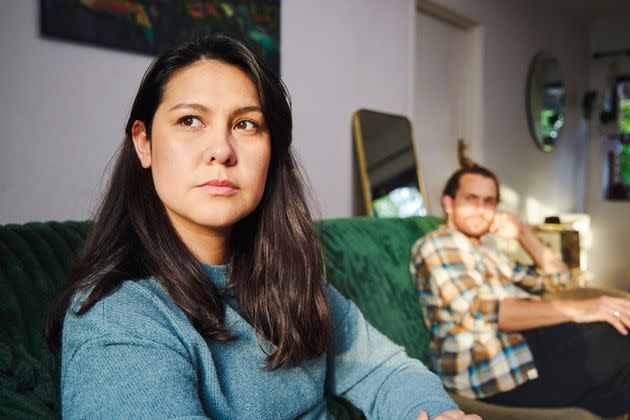5 Signs Your Partner May Have An Avoidant Attachment Style
Psychologists have been studying attachment styles for decades, but in recent years, the concept has generated quite a bit of buzz on social media.
If you’re not already familiar, your attachment style, which is essentially a way of understanding how you relate to others in your close relationships, falls into one of four categories: secure, anxious, avoidant (sometimes known as dismissive-avoidant) and disorganized (also known as fearful-avoidant).
You can read more about each attachment style here or take one of these tests (here’s a short one and a more in-depth one) to determine yours and ask your partner to do the same if you think they’d be open to it.
Here, however, we’ll focus on romantic relationships with someone who has an avoidant attachment style — characterized by a discomfort with emotional closeness, a deep need for independence and a reluctance to rely on others. Being in a relationship with someone with this attachment style comes with some unique challenges.

The bond a person has with their primary caregivers in childhood affects their attachment style in adulthood, but it’s not the only influence. One’s attachment style is not set in stone either, nor will it be the same across all of the different intimate relationships in your life.
“Be it a friend, colleague, family member or romantic partner, your attachment style that emerges varies based on the pairing and can change or grow over time,” Denver psychotherapist Brittany Bouffard told HuffPost.
“For instance, you can be in a securely attached relationship with one person, but in a different romantic relationship or friendship or familial relationship, you might embody one of the other styles.”
Below are some of the signs that might indicate your partner has an avoidant attachment style and advice to help you better understand your partner, yourself and the relationship dynamic.
1. They’re scared of commitment.
A partner with an avoidant attachment style may be reluctant to invest fully in the relationship due to fears about commitment. According to Shaurya Gahlawat, a couples therapist in India, they may avoid conversations about your future or be hesitant to make long-term plans.
“In therapy, I’ve observed clients who struggle with commitment express a fear of being trapped or suffocated by the relationship,” she told HuffPost. “This fear often stems from past experiences of rejection or abandonment, leading them to adopt a defensive stance to protect themselves from potential emotional pain.”
Appearing disinterested in connection is a key attribute of an avoidant attachment style, which can manifest as trouble committing to the relationship, Bouffard said.
“People with avoidant [attachment] can unconsciously fear feeling engulfed or overwhelmed by another person’s connection because, on many levels, they adapted toward disconnection and loneliness,” she said. “So you might feel ready to commit to a relationship or a next level but find your partner unable to express — or want — the same forward energy.”
2. They strongly value independence in the relationship.
Though maintaining your independence within a relationship is healthy, a strong need for autonomy and freedom above all else can be a sign of avoidant attachment.
“Individuals with this attachment style may prioritize their own needs and space over the needs of their partner,” Gahlawat said.

A client who was struggling with his partner’s avoidant behavior said that she would become distant whenever conflict or stress arose in the relationship.
“He felt frustrated and neglected, as she seemed more focused on maintaining her independence than nurturing their connection,” Gahlawat said. “Through therapy, she began to recognize how her avoidance of intimacy was impacting their relationship, and she learned healthier ways to balance her need for space with the partner’s need for closeness.”
Additionally, those who lean avoidant may seem very self-sufficient on the surface, “but usually inside feel easily lonely and disconnected,” Bouffard said. “Some avoidant attachers jump between brief sexual connections or short dating stints, needing to distance after the closeness.”
3. They struggle with emotional intimacy.
A partner with an avoidant attachment style likely has a hard time sharing their inner world with you. Getting them to express their thoughts, emotions and vulnerabilities can feel like pulling teeth.
“Your partner may be able to discuss some details about the events of their day, but when it comes to the part that interests you, the emotional impact of those experiences, your partner may have great difficulty giving detail about this,” Los Angeles clinical psychologist David Narang, author of the attachment style workbook “Leaving Loneliness,” told HuffPost.
During conversations about feelings, their responses are often “excessively brief” because they have trouble accessing this part of themselves, he said.
Gahlawat said she’s noticed that clients who have a hard time in this area tend to pull back or shut down when faced with emotional closeness.
“This behavior can stem from a fear of dependence or a belief that expressing vulnerability will lead to rejection or abandonment,” she said.
4. They devote more time to work than they do to the relationship.
Partners who have an avoidant attachment style may invest more time and energy in their careers than in their romantic partnerships. According to Narang, this may be because they have learned to value “the more controllable rewards that come from work.”
“Their early relationships were likely either intrusive or emotionally vacant, either way teaching them that relationships are not the place that one gains tremendous satisfaction,” he explained. “As a result, they devote their time and energy where they reflexively assume that they will experience rewards.”
You might feel ready to commit to a relationship or a next level but find your partner unable to express — or want — the same forward energy.Brittany Bouffard, psychotherapist
And because they’ve placed more value on their career, any accolades they get for working hard on the job tend to feel more satisfying to them than a well-earned relationship success, Narang said.
5. Their closed-off behavior triggers your relationship anxiety.
It’s quite common for an avoidant-attacher to couple up with an anxious-attacher. This pairing creates a “push-pull” dynamic, Bouffard said, in which the person with avoidant attachment will not communicate clearly or begin pulling away, which triggers the partner to seek reassurance about the relationship and affirm their connection.
Pay attention to how your partner’s avoidant tendencies may activate your anxious ones.
“Assess if you are feeling unaffirmed, fighting to have needs met or fearing the person will leave,” Bouffard said.
When you feel your partner distancing themselves, you might find yourself trying to “over-prove your worth” to your partner so that they’ll stick around, Bouffard said.
“You may do this by putting yourself into a box” that the avoidant person will like, in order to avoid being rejected or abandoned, “or by excessively caretaking, communicating or worrying in hopes of grasping onto the relationship,” she said.
What To Do If Your Partner Has An Avoidant Attachment Style

Presentation of an attachment style exists on a continuum, Bouffard said. And where you and your partner fall determines if the relationship is likely to be compatible.
If the relationship dynamic is relatively healthy, then learning more about their attachment history and finding coping strategies to deal with some of their frustrating behaviors may help, she said.
However, if the avoidant partner’s behaviors are so severe that you, in turn, “intensely grasp onto them, feel constantly anxious or worry it will abruptly end, it might not be a mutually healthy match,” Bouffard said.
These therapist-backed tips will help you better navigate the dynamic:
Try to be patient and understanding, as challenging as that may be.
This is one of the important pieces of advice for folks in relationships with avoidantly attached partners, Gahlawat said. Part of that is recognizing that their challenges around emotional intimacy likely stem from their upbringing or other past experiences, not because they don’t love or care about you, she said.
“I often encourage clients to approach their partner with empathy and compassion rather than judgment or frustration,” Gahlawat added.
Look for ways to express yourself that they’ll be more receptive to.
It’s natural to feel hurt or take it personally when your partner refuses to open up or tries to create distance. But if you approach the situation with anger, that is likely to overwhelm your partner, causing them to withdraw even more. Instead, try to employ a more matter-of-fact tone if you can.
“Engage your partner’s attention, and then see if he or she can tolerate hearing from you that a bit more verbal discussion would help you feel closer and to reduce some of the painful loneliness that you are feeling in the relationship,” Narang said.
“Framing the issue in terms of a way your partner could become powerfully helpful — versus emphasizing that they are currently failing — may support your partner to do the hard work of first trying to access their own experience and then verbalizing it to you.”
Remember that your needs are valid, too.
Keep in mind that your own emotions around this are reasonable. Your partner just has a hard time dealing with them “because they are easily flooded,” Narang said.
“This will help you patiently but firmly approach your partner requesting that they push themselves a bit to allow you more access to them,” he said.
Know that addressing these roadblocks will be a process.
Working through these issues will take time and effort from both parties — “a process involving multiple skirmishes, dialogues and possible couples’ therapy,” Narang said.
“After that process, hopefully you will approach them kindly and audibly when you need connection, and hopefully your partner will then respond with an effort to allow you deeper access to him/her and to listen to you more deeply,” he continued.
“Ultimately, after following through with this process, you will have to decide whether there is enough connection available in the relationship to nourish you.”
